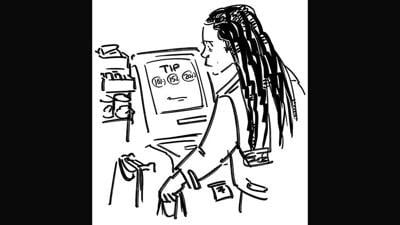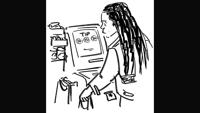Does it seem like you can’t buy anything anymore without being asked to give somebody a tip?
Not long ago, there were a limited number of instances in which tips were expected: When receiving sit-down service at a restaurant, when food was delivered by a driver, and for services by bartenders, cab drivers, bellhops and at hair and nail salons.
However, when the pandemic began, many people tipped service workers more generously and even began leaving gratuities for take-out service to compensate for closed dining rooms at restaurants.
Since then, more workers anticipate tips. And the expected amount of tips also is on the rise.
A standard tip used to be 10 percent. Then, for unknown reasons, 15 percent became the new standard. I used to be considered a generous tipper when I left 20 percent on the bill, but now that’s considered standard, if not a little stingy.
Call this “tipflation” or “tip creep” and it isn’t just my imagination.
According to Square, a financial services platform, in February 2020, just before most of us had heard of COVID, 43.4 percent of transactions involving food and drinks included tips. By February 2023, that jumped to 74.5 percent.
Think about that: Nearly twice as many businesses are putting their hands out for a tip than they did just three years ago.
Square offers electronic payment functions at many small businesses, and the company takes a cut of each transaction, including tips. More tips for the business mean more cash for Square, so I would not doubt the company encourages its clients to enable the tip screen function. Businesses have the option of disabling the tip screen, but most choose not to, so they can increase their workers’ take-home pay at no cost to their bottom line.
Recently, perhaps in response to workers striking for better wages, Starbucks started prompting customers to tip on coffee orders they had never been expected to tip on before. I’ve found the same phenomenon at local food and drink places. In the last couple of years, it has become standard for the cashier to turn the tablet screen around and prompt the customer to tip in full view of both the cashier and the customers waiting in line. That creates a situation where customers feel social pressure to tip – and tip generously – or be seen as stingy, even if they don’t believe the situation calls for anything extra.
To add to tipflation, the pre-set tip options are chosen by the business. Many suggest 20 percent, 25 percent and even 30 percent. That’s for the same sale that three or four years ago, a customer might have thrown their change into a jar on the counter – or not.
I’ve heard people argue: “But you’re tipping them for preparing your drink!” Since when is it presumed that when I pay for food or drink, its assembly isn’t factored into the price? What’s the alternative? They hand me a cup of milk and some coffee grounds?
A few weeks ago, I ordered a packaged product to go at a local bakery. Still, the screen was flipped around and I was prompted to tip. For what? For handing me the item I bought?
I think supporting local businesses is vital, which is why I stopped at this local store, knowing I would likely pay double or triple for the same item I could buy at a grocery store or chain restaurant.
Speaking of chain restaurants, recently after placing an order for takeout for fast food on an app on my phone, I was prompted to leave a tip. I placed the order myself and picked it up myself. Who would the tip even go to and for what service?
A few months ago, after signing up and paying for a yearly membership for grocery delivery, I was a bit miffed to see I was expected to tip drivers on top of the fee I was already paying for the delivery service. Suggested tipping options ranged from 5 percent to 20 percent of the amount of the order. So now, on top of being hit with the increased cost of groceries, I was being expected to fork over more money on top of that – after already paying the annual delivery fee.
Yes, delivery drivers work hard and deserve good wages. However, I believe those wages should come from their employer, not me. I pay a yearly fee to Amazon and am not expected to tip my Amazon delivery driver (Yet. Although I was just prompted to tip a seller on Amazon. Good grief.)
Even GoFundMe has waded into this fray. After I used the website to donate money to a friend in need, it prompted me for a gratuity. Why? It already claims a percentage of each donation.
I’ve even seen renters sharing stories online about their landlords asking for tips for repairs. I fear we’re getting to the point where we’ll be prompted to tip on self-checkout soon. (Really, the stores should give me a little something for ringing up and bagging my own purchases!)
I’ve got nothing against service workers. I worked in food service from age 16 to 24 for a lousy $2.13 per hour plus tips. That work was far more difficult than any of the better-paid office jobs I’ve been fortunate to land since then.
Truly, workers in the service industry deserve to be treated with kindness and respect and to be paid a living wage. But I don’t believe it’s unreasonable that their pay should come from their employer instead of extorted from customers by use of public shame and social pressure.
And yes, I am willing to pay more for goods and services if the workers are paid fairly.
Ideally, if I want a product or service, I should pay for the product or service and that should be the end of the transaction. I should not become the payroll department of every business I patronize.
So, anyway, if you enjoyed this rant, make sure to Venmo me a tip!
Just kidding.





